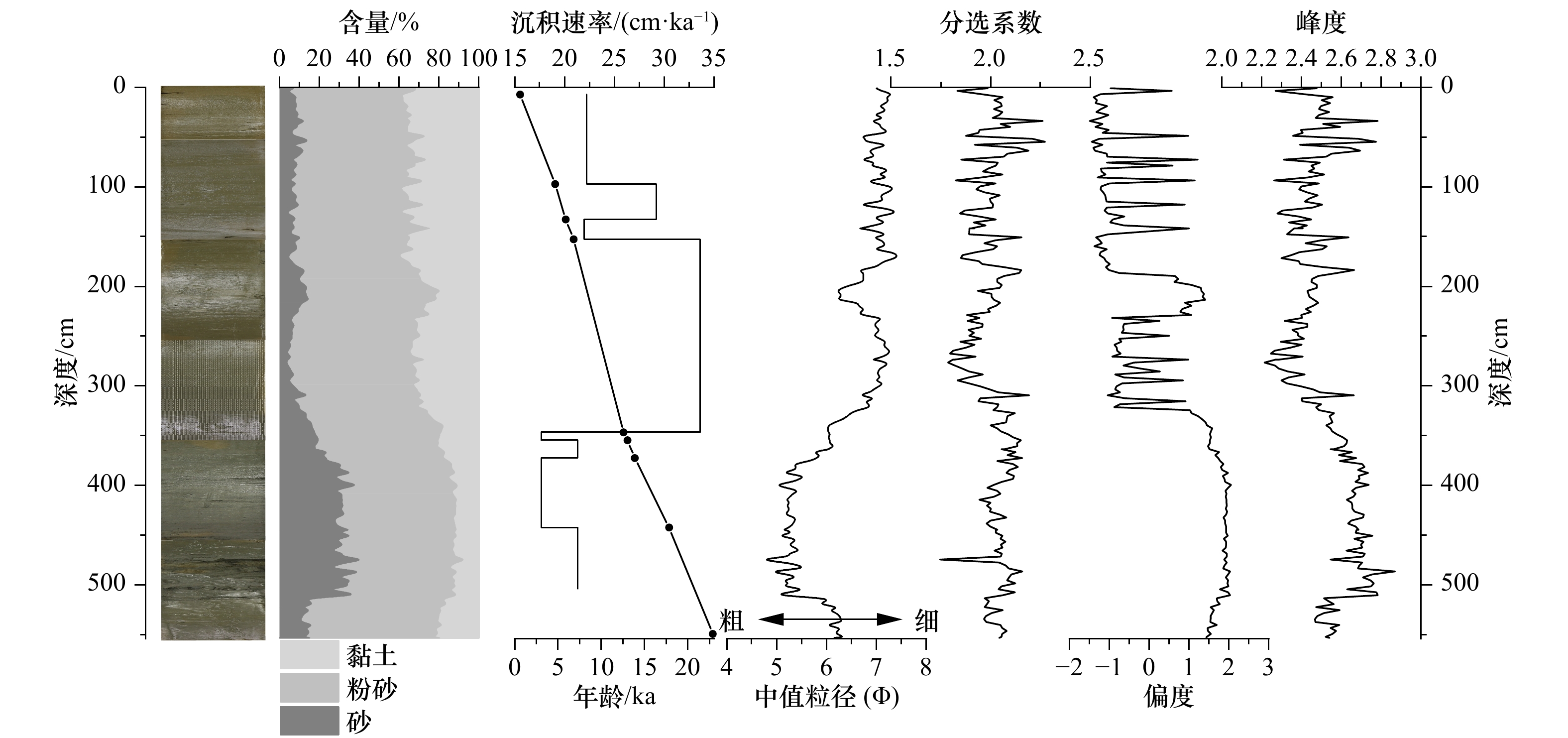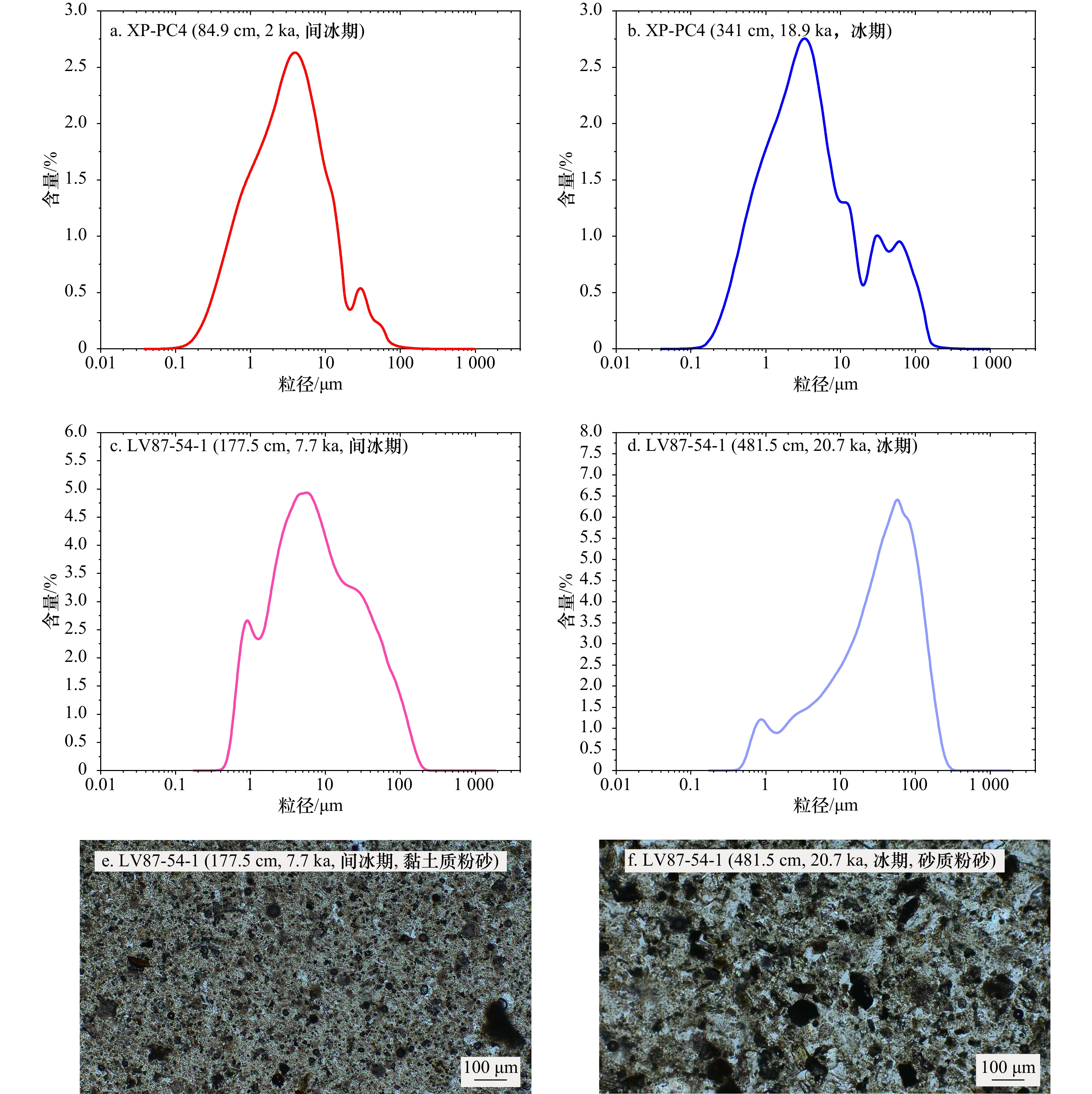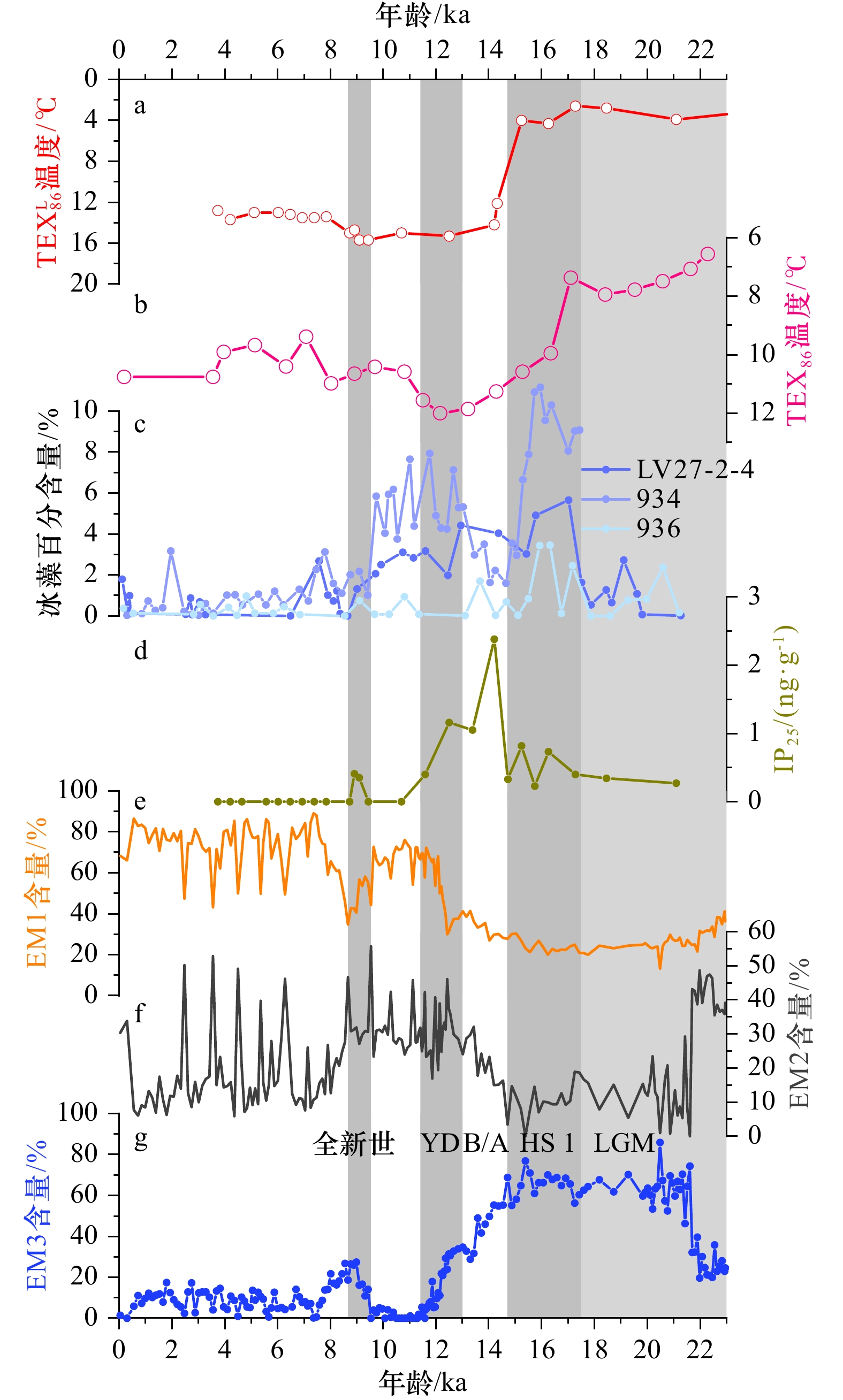Sea ice variations in the northern Okhotsk Sea shelf since the Last Glacial Maximum
-
摘要: 本文通过高分辨率粒度分析,研究了鄂霍次克海北部陆架LV87-54-1岩芯记录的海冰活动历史。利用AnalySize程序对粒度数据进行端元分析,提取了3个端元,并将EM3作为海冰指标。EM3含量结果表明,末次冰盛期以来鄂霍次克海北部陆架以活动性海冰覆盖为主。末次冰盛期和海因里希冰阶1期(HS 1)时EM3含量最高,指示海冰活动强烈。冰期时北半球中高纬度气候变冷与北极涛动负相位是导致海冰大规模扩张的主要控制机制,东亚夏季风减弱与黑龙江入海径流量的减少促使鄂霍次克海生成更多的海冰。自波令−阿勒罗德间冰阶开始以来,鄂霍次克海北部陆架海冰生成急剧减少,在新仙女木时期海冰曾出现微弱峰值,随后又快速下降。自全新世以来,受北半球中高纬度气候变暖、秋季太阳辐射量升高、北极涛动正相位和东亚夏季风的增强共同影响,EM3含量一直稳定在较低水平,鄂霍次克海海冰的生成受到明显抑制。Abstract: Here we examine the history of sea ice activity recorded in the Core LV87-54-1 recovered from the northern Okhotsk Sea shelf using high-resolution grain-size analyses. We extracted 3 end members and use EM3 as the sea-ice proxy, using the program AnalySize to conduct end members analyses on the data. According to EM3 results, active sea ice was persistently predominant in the northern Okhotsk Sea shelf since the Last Glacial Maximum. The EM3 content was high and the sea ice activity was intense during the Last Glacial Maximum and Heinrich Stadial 1. The climate cooling at the middle and high latitudes of the Northern Hemisphere and the negative Arctic Oscillation were the main controlling mechanism for sea ice expansion during glacial periods. And weakened runoff from the Amur caused by decreased East Asian Summer Monsoon would allow more sea ice formation in the Okhotsk Sea. Sea ice formation decreased at the onset of the Bølling-Allerød warm period, and then decreased sharply after a slight peak during the Younger Dryas Event. EM3 levels remained low stably since the Holocene due to: increased local autumn insolation, positive Arctic Oscillation and enhanced East Asian Summer Monsoon suppresses subsequent sea ice formation.
-
Key words:
- ice-rafted debris /
- grain-size analyses /
- end members analyses /
- sea ice variations /
- the Okhotsk Sea
1)1 注:a表示海洋沉积物的色调、色度和色值,本文使用孟塞尔颜色公司2009年修订版,2019年发行的《孟塞尔土壤比色卡》,PN(货号):M50215B -
图 1 鄂霍次克海地理位置、表层洋流系统及站位位置
红色箭头代表表层暖流,蓝色箭头代表表层寒流。ESC:东萨哈林流;WKC:西堪察加流;SC:Sredinnoe Current;OG:鄂霍次克海环流;SWC:宗谷暖流;OC:亲潮
Fig. 1 The geographical location, surface ocean current system and site locations of the Okhotsk Sea
The red arrows represent warm currents, the blue arrows represent cold currents. ESC: East Sakhalin Current; WKC: West Kamchatka Current; SC: Sredinnoe Current; OG: Okhotsk Gyre; SWC: Soya Warm Current; OC: Oyashio Current
图 6 LV87-54-1岩芯沉积物粒径端元含量变化与其他指标的对比
a. MD01-2414岩芯$\rm TEX^L_{86} $温度[8];b. MR0604-PC7B岩芯TEX86温度[49];c. LV27-2-4、936和934岩芯冰藻百分含量[50];d. MD01-2414岩芯IP25含量[8];e-g. LV87-54-1岩芯EM1、EM2、EM3含量
Fig. 6 Comparison between end members content change in the Core LV87-54-1 and other proxies
a. $\rm TEX^L_{86} $ temperature (°C) [8], the Core MD01-2414; b. TEX86 temperature (°C) [49], the Core MR0604-PC7B; c. the percentage of sea-ice diatom species in the cores LV27-2-4, 936, and 934 [50]; d. IP25 content from the Core MD01-2414 [8]; e-g. EM1, EM2, EM3 content in the Core LV87-54-1
图 7 LV87-54-1 岩芯沉积物粒径端元含量变化与其他古气候指标的对比
a. 57°N秋季太阳辐射量;b. 模拟的鄂霍次克海11月份海冰指数[8];c. 石笋氧同位素[51],指示东亚夏季风(EASM)的强弱;d. North Greenland Ice Core Project(NGRIP)氧同位素[52],指示水极涛动(AO)强度;e. 极地大气环流指数(PCI)[53],指示AO强度;f-h. LV87-54-1岩芯EM1、EM2、EM3含量
Fig. 7 Comparison between end members content change in the Core LV87-54-1 and other paleoclimate proxies
a. September-October-November insolation at 57°N; b. model-derived Okhotsk Sea November sea ice index [8]; c. oxygen isotopes of stalagmite [51], a proxy of East Asian Summer Monsoon; d. oxygen isotopes of North Greenland Ice Core Project (NGRIP) ice core [52], a proxy for Arctic Oscillation variation; e. Polar Circulation Index (PCI) [53], indicating Arctic Oscillation variations ; f-h. EM1, EM2, EM3 content in the Core LV87-54-1
表 1 LV87-54-1岩芯的AMS 14C测年数据、日历年校正结果以及线性沉积速率
Tab. 1 AMS 14C dating data, the calendar ages and linear sedimentation rate of the Core LV87-54-1
深度/
cm测年材料 常规放射性
碳年龄/a BP日历年校正/
Cal a BP线性沉积速率/
(cm·ka−1)7 底栖有孔虫 1 330±30 599 22.19 97 底栖有孔虫 4 760±30 4 655 29.19 132.5 底栖有孔虫 5 800±30 5 871 21.98 152.5 底栖有孔虫 6 620±30 6 781 27.65 346.5 陆源木头 10 500±30 12 555 17.66 346.5 底栖有孔虫 11 290±30 12 555 17.66 354.5 底栖有孔虫 11 840±30 13 008 21.30 372.5 底栖有孔虫 12 670±30 13 853 17.66 442.5 底栖有孔虫 15 340±50 17 816 5.47 549.5 底栖有孔虫 19 680±60 22 831 表 2 LV87-54-1岩芯沉积物粒径端元EM1、EM2和EM3的参数特征
Tab. 2 Characteristics of the grain-size of modeled end members EM1, EM2 and EM3 of the Core LV87-54-1
端元 平均粒径/μm 分选系数 偏度 峰度 EM1 4.95 3.69 0.63 3.23 EM2 16.36 2.44 0.12 2.72 EM3 51.94 2.19 −0.49 3.24 -
[1] Flanner M G, Shell K M, Barlage M, et al. Radiative forcing and albedo feedback from the Northern Hemisphere cryosphere between 1979 and 2008[J]. Nature Geoscience, 2011, 4(3): 151−155. doi: 10.1038/ngeo1062 [2] Goosse H, Zunz V. Decadal trends in the Antarctic sea ice extent ultimately controlled by ice-ocean feedback[J]. The Cryosphere, 2014, 8(2): 453−470. doi: 10.5194/tc-8-453-2014 [3] Sakamoto T, Ikehara M, Aoki K, et al. Ice-rafted debris (IRD)-based sea-ice expansion events during the past 100 kyrs in the Okhotsk Sea[J]. Deep-Sea Research Part II: Topical Studies in Oceanography, 2005, 52(16/18): 2275−2301. [4] Sakamoto T, Ikehara M, Uchida M, et al. Millennial-scale variations of sea-ice expansion in the southwestern part of the Okhotsk Sea during the past 120 kyr: age model and ice-rafted debris in IMAGES Core MD01-2412[J]. Global and Planetary Change, 2006, 53(1/2): 58−77. [5] Ohshima K I, Nakanowatari T, Riser S, et al. Freshening and dense shelf water reduction in the Okhotsk Sea linked with sea ice decline[J]. Progress in Oceanography, 2014, 126: 71−79. doi: 10.1016/j.pocean.2014.04.020 [6] Talley L D. An Okhotsk Sea water anomaly: implications for ventilation in the North Pacific[J]. Deep-Sea Research Part A: Oceanographic Research Papers, 1991, 38(S1): S171−S190. [7] Yasuda I. The origin of the North Pacific intermediate water[J]. Journal of Geophysical Research:Oceans, 1997, 102(C1): 893−909. doi: 10.1029/96JC02938 [8] Lo L, Belt S T, Lattaud J, et al. Precession and atmospheric CO2 modulated variability of sea ice in the central Okhotsk Sea since 130, 000 years ago[J]. Earth and Planetary Science Letters, 2018, 488: 36−45. doi: 10.1016/j.jpgl.2018.02.005 [9] Nürnberg D, Tiedemann R. Environmental change in the Sea of Okhotsk during the last 1.1 million years[J]. Paleoceanography, 2004, 19(4): PA4011. [10] Nürnberg D, Dethleff D, Tiedemann R, et al. Okhotsk Sea ice coverage and Kamchatka glaciation over the last 350 ka-Evidence from ice-rafted debris and planktonic δ18O[J]. Palaeogeography, Palaeoclimatology, Palaeoecology, 2011, 310(3/4): 191−205. [11] Vasilenko Y P, Gorbarenko S A, Bosin A A, et al. Millennial mode of variability of sea ice conditions in the Okhotsk Sea during the last glaciation (MIS 4-MIS 2)[J]. Quaternary International, 2017, 459: 187−200. doi: 10.1016/j.quaint.2017.09.039 [12] Vasilenko Y P, Gorbarenko S A, Bosin A A, et al. Orbital-scale changes of sea ice conditions of Sea of Okhotsk during the last glaciation and the Holocene (MIS 4-MIS 1)[J]. Palaeogeography, Palaeoclimatology, Palaeoecology, 2019, 533: 109284. doi: 10.1016/j.palaeo.2019.109284 [13] Wang W L, Wang Liangchi. Reconstruction of oceanographic changes based on the diatom records of the central Okhotsk Sea over the last 500000 years[J]. Terrestrial, Atmospheric and Oceanic Sciences, 2008, 19(4): 403−411. doi: 10.3319/TAO.2008.19.4.403(IMAGES) [14] Gorbarenko S A, Yanchenko E A, Psheneva O Y, et al. Orbital and millennial-scale environmental and hydrological changes of the central Okhotsk Sea over the last 136 kyr inferred from micropaleontological (radiolarian and benthic foraminifera), geochemical and lithological proxies and the mechanisms responsible for them[J]. Quaternary Science Reviews, 2020, 247: 106569. doi: 10.1016/j.quascirev.2020.106569 [15] Kimura N, Wakatsuchi M. Relationship between sea-ice motion and geostrophic wind in the Northern Hemisphere[J]. Geophysical Research Letters, 2000, 27(22): 3735−3738. doi: 10.1029/2000GL011495 [16] Kimura N, Wakatsuchi M. Mechanisms for the variation of sea ice extent in the Northern Hemisphere[J]. Journal of Geophysical Research: Oceans, 2001, 106(C12): 31319−31331. doi: 10.1029/2000JC000739 [17] Ogi M, Tachibana Y. Influence of the annual Arctic Oscillation on the negative correlation between Okhotsk Sea ice and Amur River discharge[J]. Geophysical Research Letters, 2006, 33(8): L08709. [18] Ogi M, Tachibana Y, Nishio F, et al. Does the fresh water supply from the Amur River flowing into the Sea of Okhotsk affect sea ice formation?[J]. Journal of the Meteorological Society of Japan, 2001, 79(1): 123−129. [19] Gorbarenko S A, Tsoi I B, Astakhov A S, et al. Paleoenvironmental changes in the northern shelf of the Sea of Okhotsk during the Holocene[J]. Stratigraphy and Geological Correlation, 2007, 15(6): 656−671. doi: 10.1134/S0869593807060044 [20] Parkinson C L. The impact of the Siberian high and Aleutian low on the sea-ice cover of the sea of Okhotsk[J]. Annals of Glaciology, 1990, 14: 226−229. doi: 10.3189/S0260305500008636 [21] Ponomarev V, Trusenkova O, Ustinova E, et al. Interannual variations of oceanographic and meteorological characteristics in the Sea of Okhotsk[R]. PICES Scientific Report, 1998: 31−40. [22] Lisitzin A P. Sea-Ice and Iceberg Sedimentation in the Ocean: Recent and Past[M]. Berlin, Heidelberg: Springer, 2002. [23] Overland J E, Adams J M, Bond N A. Decadal variability of the Aleutian low and its relation to high-latitude circulation[J]. Journal of Climate, 1999, 12(5): 1542−1548. doi: 10.1175/1520-0442(1999)012<1542:DVOTAL>2.0.CO;2 [24] Thompson D W J, Wallace J M. The Arctic oscillation signature in the wintertime geopotential height and temperature fields[J]. Geophysical Research Letters, 1998, 25(9): 1297−1300. doi: 10.1029/98GL00950 [25] Minervin I G, Romanyuk V A, Pishchal’nik V M, et al. Zoning the ice cover of the Sea of Okhotsk and the Sea of Japan[J]. Herald of the Russian Academy of Sciences, 2015, 85(2): 132−139. doi: 10.1134/S1019331615010049 [26] Kimura N, Wakatsuchi M. Processes controlling the advance and retreat of sea ice in the Sea of Okhotsk[J]. Journal of Geophysical Research: Oceans, 1999, 104(C5): 11137−11150. doi: 10.1029/1999JC900004 [27] Kovanen D J, Easterbrook D J. Paleodeviations of radiocarbon marine reservoir values for the northeast Pacific[J]. Geology, 2002, 30(3): 243−246. doi: 10.1130/0091-7613(2002)030<0243:PORMRV>2.0.CO;2 [28] Kuzmin Y V, Burr G S, Gorbunov S V, et al. A tale of two seas: reservoir age correction values (R, ΔR) for the Sakhalin Island (Sea of Japan and Okhotsk Sea)[J]. Nuclear Instruments and Methods in Physics Research Section B: Beam Interactions with Materials and Atoms, 2007, 259(1): 460−462. [29] Yoneda M, Uno H, Shibata Y, et al. Radiocarbon marine reservoir ages in the western Pacific estimated by pre-bomb molluscan shells[J]. Nuclear Instruments and Methods in Physics Research Section B: Beam Interactions with Materials and Atoms, 2007, 259(1): 432−437. doi: 10.1016/j.nimb.2007.01.184 [30] Reimer P J, Bard E, Bayliss A, et al. IntCal13 and marine13 radiocarbon age calibration curves 0-50, 000 years cal BP[J]. Radiocarbon, 2013, 55(4): 1869−1887. doi: 10.2458/azu_js_rc.55.16947 [31] Friedman G M. Comparison of moment measures for sieving and thin-section data in sedimentary petrological studies[J]. Journal of Sedimentary Research, 1962, 32(1): 15−25. [32] 孙有斌, 高抒, 李军. 边缘海陆源物质中环境敏感粒度组分的初步分析[J]. 科学通报, 2003, 48(2): 184−187. doi: 10.3321/j.issn:0023-074X.2003.01.021Sun Youbin, Gao Shu, Li Jun. Preliminary analysis of grain-size populations with environmentally sensitive terrigenous components in marginal sea setting[J]. Chinese Science Bulletin, 2003, 48(2): 184−187. doi: 10.3321/j.issn:0023-074X.2003.01.021 [33] Xiang Rong, Yang Zuosheng, Saito Y, et al. East Asia Winter Monsoon changes inferred from environmentally sensitive grain-size component records during the last 2300 years in mud area southwest off Cheju Island, ECS[J]. Science in China Series D, 2006, 49(6): 604−614. doi: 10.1007/s11430-006-0604-1 [34] Xiao Shangbin, Li Anchun, Liu J P, et al. Coherence between solar activity and the East Asian winter monsoon variability in the past 8000 years from Yangtze River-derived mud in the East China Sea[J]. Palaeogeography, Palaeoclimatology, Palaeoecology, 2006, 237(2/4): 293−304. [35] Hu Bangqi, Yang Zuosheng, Zhao Meixun, et al. Grain size records reveal variability of the East Asian Winter Monsoon since the Middle Holocene in the Central Yellow Sea mud area, China[J]. Science China Earth Sciences, 2012, 55(10): 1656−1668. doi: 10.1007/s11430-012-4447-7 [36] Weltje G J. End-member modeling of compositional data: numerical-statistical algorithms for solving the explicit mixing problem[J]. Mathematical Geology, 1997, 29(4): 503−549. doi: 10.1007/BF02775085 [37] Weltje G J, Prins M A. Muddled or mixed? Inferring palaeoclimate from size distributions of deep-sea clastics[J]. Sedimentary Geology, 2003, 162(1/2): 39−62. [38] Wan Shiming, Li Anchun, Clift P D, et al. Development of the East Asian monsoon: mineralogical and sedimentologic records in the northern South China Sea since 20 Ma[J]. Palaeogeography, Palaeoclimatology, Palaeoecology, 2007, 254(3/4): 561−582. [39] Prins M A, Vriend M, Nugteren G, et al. Late Quaternary aeolian dust input variability on the Chinese Loess Plateau: inferences from unmixing of loess grain-size records[J]. Quaternary Science Reviews, 2007, 26(1/2): 230−242. [40] Paterson G A, Heslop D. New methods for unmixing sediment grain size data[J]. Geochemistry, Geophysics, Geosystems, 2015, 16(12): 4494−4506. doi: 10.1002/2015GC006070 [41] Gorbarenko S A, Nürnberg D, Derkachev A N, et al. Magnetostratigraphy and tephrochronology of the Upper Quaternary sediments in the Okhotsk Sea: implication of terrigenous, volcanogenic and biogenic matter supply[J]. Marine Geology, 2002, 183(1/4): 107−129. [42] Derkachev A N, Nikolaeva N A, Gorbarenko S A, et al. Tephra layers of in the quaternary deposits of the Sea of Okhotsk: distribution, composition, age and volcanic sources[J]. Quaternary International, 2016, 425: 248−272. doi: 10.1016/j.quaint.2016.07.004 [43] Jickells T D, An Z S, Andersen K K, et al. Global iron connections between desert dust, ocean biogeochemistry, and climate[J]. Science, 2005, 308(5718): 67−71. doi: 10.1126/science.1105959 [44] Uematsu M, Wang Zifa, Uno I. Atmospheric input of mineral dust to the western North Pacific region based on direct measurements and a regional chemical transport model[J]. Geophysical Research Letters, 2003, 30(6): 1342. [45] Seki O, Kawamura K, Nakatsuka T, et al. Sediment core profiles of long-chain n-alkanes in the Sea of Okhotsk: enhanced transport of terrestrial organic matter from the last deglaciation to the early Holocene[J]. Geophysical Research Letters, 2003, 30(1): 1001. [46] Nakatsuka T, Toda M, Kawamura K, et al. Dissolved and particulate organic carbon in the Sea of Okhotsk: transport from continental shelf to ocean interior[J]. Journal of Geophysical Research: Oceans, 2004, 109(C9): C09S14. [47] Yasuda T, Asahara Y, Ichikawa R, et al. Distribution and transport processes of lithogenic material from the Amur River revealed by the Sr and Nd isotope ratios of sediments from the Sea of Okhotsk[J]. Progress in Oceanography, 2014, 126: 155−167. doi: 10.1016/j.pocean.2014.04.015 [48] Braitseva O A, Sulerzhitsky L D, Litasova S N, et al. Radiocarbon dating and tephrochronology in Kamchatka[J]. Radiocarbon, 1993, 35(3): 463−476. doi: 10.1017/S0033822200060495 [49] Seki O, Sakamoto T, Sakai S, et al. Large changes in seasonal sea ice distribution and productivity in the Sea of Okhotsk during the deglaciations[J]. Geochemistry, Geophysics, Geosystems, 2009, 10(10): Q10007. [50] Gorbarenko S A, Artemova A V, Goldberg E L, et al. The response of the Okhotsk Sea environment to the orbital-millennium global climate changes during the Last Glacial Maximum, deglaciation and Holocene[J]. Global and Planetary Change, 2014, 116: 76−90. doi: 10.1016/j.gloplacha.2014.02.002 [51] Cheng Hai, Edwards R L, Sinha A, et al. The Asian monsoon over the past 640, 000 years and ice age terminations[J]. Nature, 2016, 534(7609): 640−646. doi: 10.1038/nature18591 [52] North Greenland Ice Core Project Members. High-resolution record of Northern Hemisphere climate extending into the last interglacial period[J]. Nature, 2004, 431(7005): 147−151. doi: 10.1038/nature02805 [53] Mayewski P A, Meeker L D, Twickler M S, et al. Major features and forcing of high-latitude northern hemisphere atmospheric circulation using a 110, 000-year-long glaciochemical series[J]. Journal of Geophysical Research: Oceans, 1997, 102(C12): 26345−26366. doi: 10.1029/96JC03365 [54] Shakun J D, Clark P U, He Feng, et al. Global warming preceded by increasing carbon dioxide concentrations during the last deglaciation[J]. Nature, 2012, 484(7392): 49−54. doi: 10.1038/nature10915 [55] Méheust M, Stein R, Fahl K, et al. Sea-ice variability in the subarctic North Pacific and adjacent Bering Sea during the past 25 ka: new insights from IP25 and $\rm U^{k′}_{37} $ proxy records[J]. Arktos, 2018, 4(1): 1−19.[56] Harada N, Sato M, Sakamoto T. Freshwater impacts recorded in tetraunsaturated alkenones and alkenone sea surface temperatures from the Okhotsk Sea across millennial-scale cycles[J]. Paleoceanography, 2008, 23(3): PA3201. [57] Cavalieri D J, Parkinson C L. On the relationship between atmospheric circulation and the fluctuations in the sea ice extents of the Bering and Okhotsk Seas[J]. Journal of Geophysical Research: Oceans, 1987, 92(C7): 7141−7162. doi: 10.1029/JC092iC07p07141 [58] Ternois Y, Kawamura K, Ohkouchi N, et al. Alkenone sea surface temperature in the Okhotsk Sea for the last 15 kyr[J]. Geochemical Journal, 2000, 34(4): 283−293. doi: 10.2343/geochemj.34.283 [59] Harada N, Ahagon N, Sakamoto T, et al. Rapid fluctuation of alkenone temperature in the southwestern Okhotsk Sea during the past 120 ky[J]. Global and Planetary Change, 2006, 53(1/2): 29−46. [60] Max L, Riethdorf J R, Tiedemann R, et al. Sea surface temperature variability and sea-ice extent in the subarctic northwest Pacific during the past 15, 000 years[J]. Paleoceanography, 2012, 27(3): PA3213. [61] Samko E, Glebova S, Petruk V. The influence of atmospheric processes on the water circulation off the west Kamchatka coast[R]. PICES Scientific Report, American Geosciences Institute, 2003: 7−12. -





 下载:
下载:







